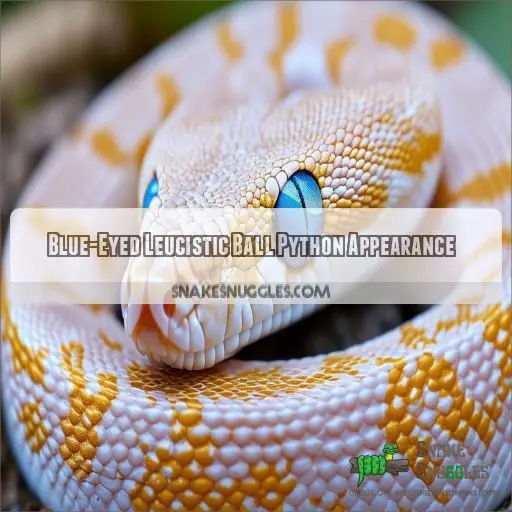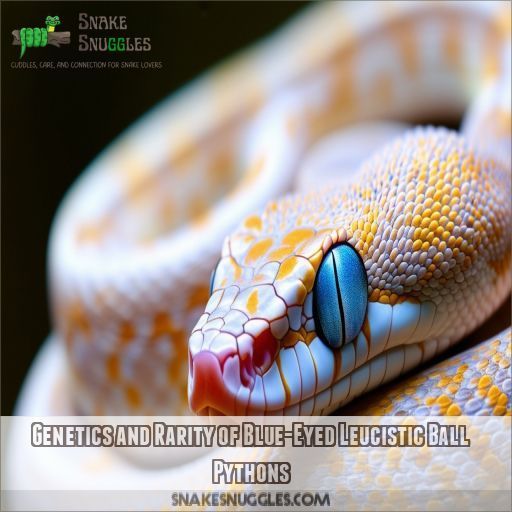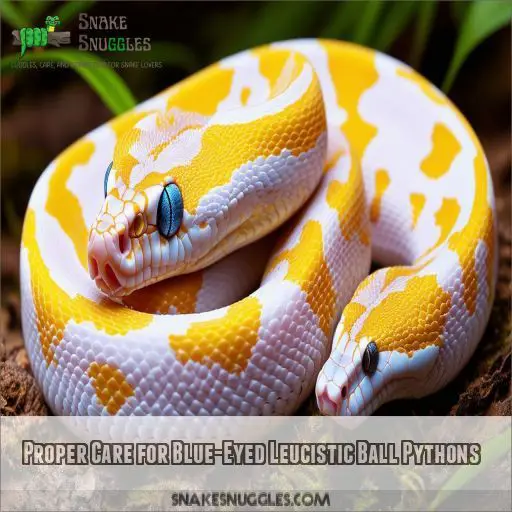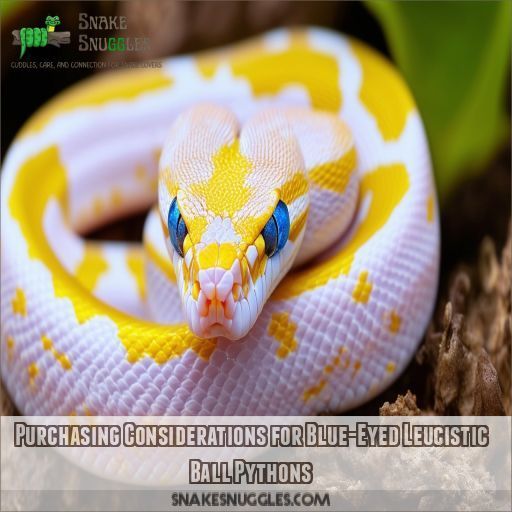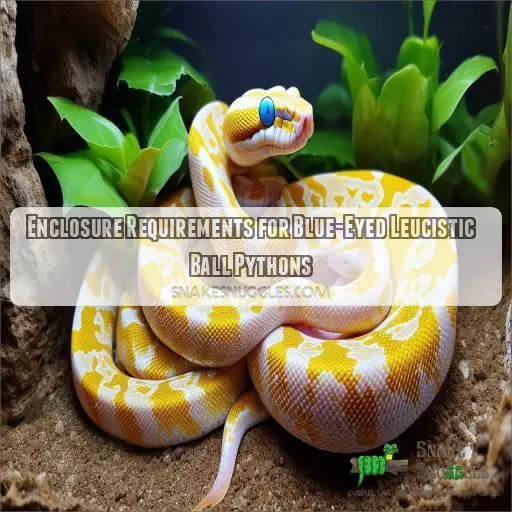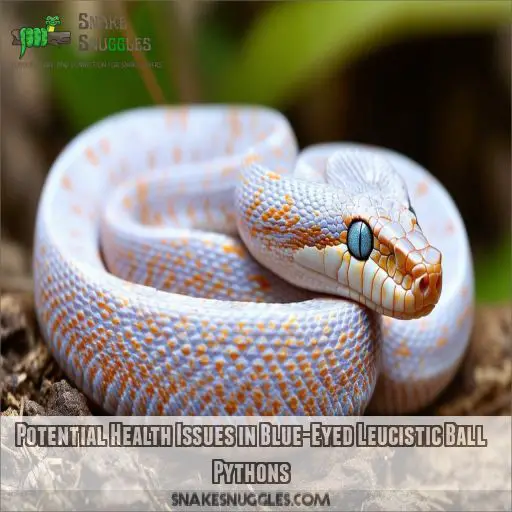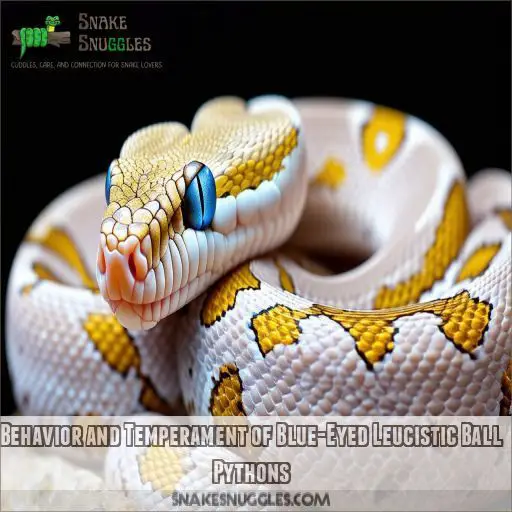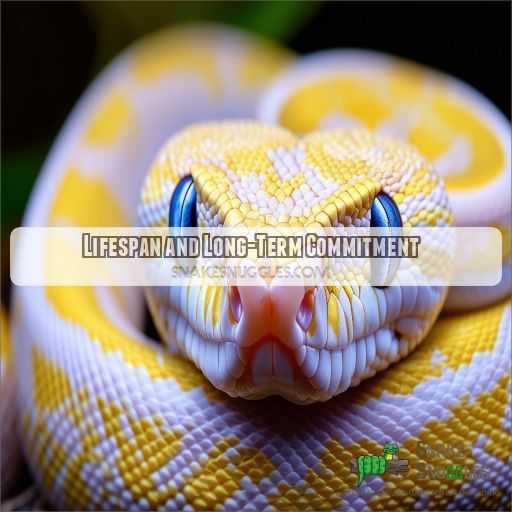This site is supported by our readers. We may earn a commission, at no cost to you, if you purchase through links.
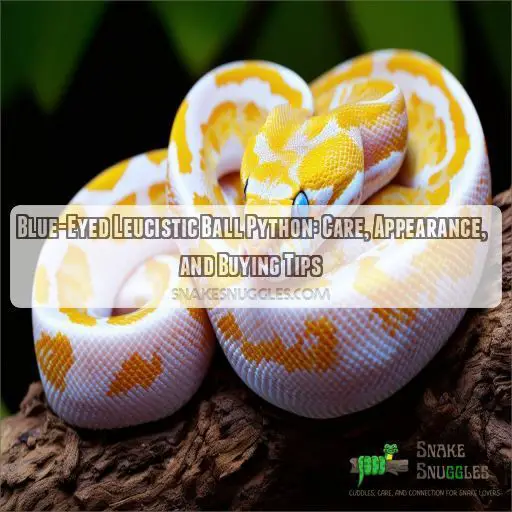
They are genetically distinct and rare, making them highly sought after by collectors. Caring for them is similar to other ball pythons, requiring consideration of their temperament and handling needs, such as being calm and docile but shy and less active, as discussed in ball python vs corn snake. You’ll need a secure enclosure with a temperature gradient, proper humidity, and regular feeding and handling practices.
If you choose a reputable breeder, you’re ensuring a healthy pet. Ready to bring one home? Discover more about their care next.
Table Of Contents
- Key Takeaways
- Blue-Eyed Leucistic Ball Python Appearance
- Genetics and Rarity of Blue-Eyed Leucistic Ball Pythons
- Proper Care for Blue-Eyed Leucistic Ball Pythons
- Purchasing Considerations for Blue-Eyed Leucistic Ball Pythons
- Enclosure Requirements for Blue-Eyed Leucistic Ball Pythons
- Top 6 Products for Blue-Eyed Leucistic Ball Python Care
- Potential Health Issues in Blue-Eyed Leucistic Ball Pythons
- Behavior and Temperament of Blue-Eyed Leucistic Ball Pythons
- Lifespan and Long-Term Commitment
- Frequently Asked Questions (FAQs)
- Are blue-eyed leucistic ball pythons rare?
- Are blue-eyed leucistic ball pythons poisonous?
- How to get a blue eyed lucy ball python?
- What is the personality of a leucistic ball python?
- How often should ball pythons be fed?
- What is the average hatching size?
- Are blue-eyed leucistic ball pythons good with children?
- How do I maintain humidity levels?
- Can they cohabitate with other reptiles?
- Conclusion
Key Takeaways
- These snakes are the supermodels of the reptile world – pure white scales and icy blue eyes that’ll make you do a double-take! Just don’t expect them to strut down a catwalk anytime soon.
- Caring for a blue-eyed leucistic ball python isn’t rocket science, but it does require some TLC. Think of yourself as their personal butler – providing a cozy home, just-right temperatures, and room service (aka regular feedings).
- These rare beauties are the result of some serious matchmaking in the snake world. Breeders play Cupid with specific morphs to create these genetic gems, making them quite the hot commodity among collectors.
- If you’re looking for a long-term relationship, you’ve hit the jackpot! These pythons can live up to 30 years or more. That’s longer than some Hollywood marriages, folks!
Blue-Eyed Leucistic Ball Python Appearance
When observing a Blue-Eyed Leucistic Ball Python, you’ll notice their stunning pure white coloration paired with piercing icy blue eyes. These snakes typically measure between 3-5 feet in length, feature stocky bodies, smaller heads, and may have a subtle tan stripe along their spine, making them a visual standout among ball python morphs.
Pure White Coloration With Icy Blue Eyes
The blue-eyed leucistic ball python, often called "blue eyed Lucy," flaunts a unique appearance, marked by its pure white coloration and piercing icy blue eyes. This stunning combination contributes substantially to its demand and rarity among collectors. Produced through specific captive breeding practices, their striking genetic makeup resembles other ball pythons but with these distinct features.
May Have a Tan Stripe Along Spine
A Blue-Eyed Leucistic (BEL) ball python may exhibit a tan stripe along its spine, showcasing its unique genetic variation and adding to its distinct color morph. This dorsal stripe:
- Enhances its appearance
- Highlights its breeding potential
- Differentiates it from other ball pythons
- Often runs the length of the body
- Can vary in prominence
Typically Grow 3-5 Feet Long
When discussing the blue-eyed leucistic ball python’s appearance, their body size is a notable characteristic. These snakes typically grow 3-5 feet long, offering a compact size comparison to other reptiles. Their growth rate is steady, and they thrive in appropriate enclosures with suitable substrates. Consider their geographic distribution and preferred tank mates when searching for a ball python for sale.
Stocky Bodies With Smaller Heads
You’ll notice that Blue-Eyed Leucistic Ball Pythons have stocky bodies with smaller heads. This unique morphology, a result of various morph combinations and albino genes, offers impressive pattern variations compared to other ball python morphs. These robust bodies enable:
- Strong muscle support.
- Efficient heat regulation.
- Enhanced climbing ability.
- Steady ground movement.
Handling these pythons with care is paramount.
Weigh Approximately 3-4 Ibs
Weighing around 3-4 lbs, Blue-Eyed Leucistic Ball Pythons boast a pure white body with icy blue eyes and sometimes a subtle tan stripe along the spine. Their morph genetics, shared with albino, pastel, and piebald ball pythons, make them unique. Proper nutrition and temperature management are essential to maintaining their weight within healthy variations.
Genetics and Rarity of Blue-Eyed Leucistic Ball Pythons
You’ll find Blue-Eyed Leucistic Ball Pythons to be genetically distinct from other morphs, produced by breeding Mojaves, Lessers, Butters, Phantoms, and Het Russos. Their rarity in the pet trade and high demand among collectors make them a sought-after treasure.
Produced by Breeding Specific Morphs
The Blue-Eyed Leucistic Ball Python is produced through precise breeding strategies involving the genetic combination of morphs such as Mojaves, Lessers, Butters, Phantoms, and Het Russos. These breeding efforts guarantee the desired genetic variation. Here are three significant aspects of this process:
- Line breeding enhances specific traits.
- Inbreeding is avoided to prevent defects.
- Preserving genetic diversity maintains python health.
Genetically Distinct From Other Ball Python Morphs
The Blue-Eyed Leucistic Ball Python is genetically distinct from other morphs, produced through selective breeding of various morphological variants. This guarantees unique genetic diversity, often achieved via captive breeding programs. These initiatives support the conservation of the species by maintaining health and minimizing risks of issues such as puncture wounds and internal damage. Here’s a comparison table:
| Feature | Pure White Ball Python | Other Ball Python Morphs |
|---|---|---|
| Main Color | Pure White | Varies |
| Eye Color | Icy Blue | Wide Range |
| Breeding Complexity | High | Moderate |
| Genetic Diversity | Unique Lineage | Varies |
| Conservation Focus | High | Medium |
Combining careful care with strategic breeding practices safeguards the continued health of this rare and engaging snake.
Rare in the Pet Trade
Due to their genetic uniqueness and the careful breeding required, Blue-Eyed Leucistic Ball Pythons are quite rare in the pet trade. They’re typically produced by breeding specific morphs, making them distinct from other ball python varieties. Make certain you source them from reputable breeders, and remember, proper humidity and handling avoid stress-induced issues like improper feeding and prey scent confusion.
High Demand Among Collectors
Because of their enchanting blue-eyed genetics and mesmerizing appearance, Blue-Eyed Leucistic Ball Pythons are a highly sought-after commodity among collectors. The high demand can make these snakes quite rare. Prioritizing captive breeding over wild-caught specimens is essential to avoid health and ethical issues, ensuring these unique pythons’ varied color remains safe and sustainable.
Proper Care for Blue-Eyed Leucistic Ball Pythons
To care for a Blue-Eyed Leucistic Ball Python, guarantee a secure enclosure with a temperature gradient and appropriate humidity levels. Handle them properly and feed them according to their dietary requirements and schedule.
Similar to Other Ball Pythons
Blue-eyed leucistic ball pythons require care similar to other ball pythons, guaranteeing effective temperature regulation, humidity management, and behavioral enrichment. Their maintenance includes proper captive breeding practices to guarantee genetic diversity. Such an environment mimics their natural habitat, promoting their health and wellbeing, making them an ideal pet for dedicated reptile enthusiasts.
Requires a Secure Enclosure
To guarantee your Blue-Eyed Leucistic Ball Python flourishes, create a secure enclosure:
- Enclosure size and dimensions: An adult needs at least a 40-gallon tank.
- Substrate options: Use cypress mulch, coconut fiber, or organic topsoils.
- Humidity range: Maintain appropriate levels for their health.
A well-structured habitat is essential for their well-being.
Needs a Temperature Gradient and Humidity Range
Maintaining the appropriate temperature gradient and humidity levels is essential for your Blue-Eyed Leucistic Ball Python. Make sure the enclosure has a warm side (88°F-92°F) and a cool side (78°F-80°F). Utilize heating equipment such as heat pads or lamps.
Additionally, monitor humidity levels, aiming for 50%-60%, with occasional fluctuations during shedding. Regularly check and adjust these parameters for gradient maintenance.
Proper Handling and Feeding Practices
Handling your Blue-Eyed Leucistic Ball Python with care is essential. Provide support for the snake’s entire body to minimize stress. Feed prey of an appropriate size on a regular schedule for maximum growth. Offer:
- Weekly meals for juveniles
- Twice weekly for adults
- Prey no larger than the mid-section’s circumference
- Vitamin and mineral supplementation
- Observation for signs of overfeeding
Purchasing Considerations for Blue-Eyed Leucistic Ball Pythons
When buying a blue-eyed leucistic ball python, verify captive breeding and purchase from reputable breeders to guarantee a healthy snake. Consider lifetime support and guarantees from the seller, and avoid wild-caught specimens to prevent health and ethical issues.
Ensure Captive Breeding
Guarantee captive breeding to support genetic diversity, ethical considerations, and long-term care of Blue-Eyed Leucistic Ball Pythons. Responsible breeders participate in captive breeding programs, ensuring healthier, well-adapted snakes. Always confirm the source, prioritizing ethical practices and the health of the python.
| Captive Breeding | Wild-Caught | Key Considerations |
|---|---|---|
| High | Low | Genetic diversity |
| Responsible | Irresponsible | Ethical considerations |
| Healthier | Disease-prone | Long-term care |
| Legal | Often illegal | Captive breeding programs |
| Sustainable | Unsustainable | Prioritize snake’s welfare |
Purchase From Reputable Breeders
When you’re ready to buy a Blue-Eyed Leucistic Ball Python, seek reputable breeders. This guarantees robust genetics, proper temperament, and overall health. A trustworthy breeder provides documentation on lineage and captive breeding, reducing the risk of disease and stress associated with wild-caught specimens. A dedicated breeder prioritizes the snake’s well-being and provides valuable guidance on proper enclosure setup.
Consider Lifetime Support and Guarantees
When purchasing a Blue-Eyed Leucistic Ball Python, consider lifetime support and guarantees to confirm genetic stability and address breeding challenges. Check if the breeder offers:
- Genetic documentation for the snake.
- Ethical considerations for breeding practices.
- Conservation concerns managed appropriately.
This confirms your investment is backed and adds future research value.
Avoid Wild-caught Specimens
Avoid wild-caught specimens to support sustainability and ethical conservation efforts. Captive breeding provides healthier snakes and a reduced impact on wild populations. Wild-caught ball pythons often face adjustment issues and can bring exotic pet trade risks. Buying from reputable breeders ensures that you’re getting a well-acclimated pet, contributing positively to conservation ethics and overall animal welfare.
Enclosure Requirements for Blue-Eyed Leucistic Ball Pythons
For blue-eyed leucistic ball pythons, adults need at least a 40-gallon enclosure, while hatchlings and juveniles benefit from smaller environments suited to their size. Providing at least three hides, along with climbing materials and fake or real plants, guarantees a secure and enriched habitat.
Adults Need at Least a 40-gallon Enclosure
For adult Blue-Eyed Leucistic Ball Pythons, a 40-gallon enclosure is essential. Make certain it includes various substrate types such as cypress mulch or coconut fiber to maintain humidity requirements. Incorporate climbing materials and multiple hiding places for security. Maintain appropriate temperatures with a gradient from a warm basking spot to a cooler area to keep your python healthy and content.
Hatchlings and Juveniles Need Smaller Environments
Hatchlings and juvenile Blue-Eyed Leucistic Ball Pythons require smaller enclosures than adults. A 20-gallon cage size suffices, providing space for exploration and growth. Guarantee that their habitat needs include proper humidity, heating, and hiding spots. Maintain a consistent feeding schedule to avoid health concerns. When handling, support their entire body to prevent stress and injury.
Require at Least Three Hides
Confirm that your Blue-Eyed Leucistic Ball Python has three hides for comfort and security. This reduces stress and mimics their natural habitat. Key considerations are:
- Place hides at different temperature zones.
- Use moisture-retaining materials to maintain humidity.
- Provide enrichment to boost mental health.
- Confirm hides are spacious enough.
- Monitor for signs of wear or damage to replace promptly.
Climbing Materials and Fake or Real Plants Are Necessary
To enrich your Blue-Eyed Leucistic Ball Python’s habitat, make sure to include climbing materials and both fake and live plants. These items simulate their natural environment, providing necessary hiding places and mental stimulation. Enclosure decorations enhance their overall well-being and encourage natural behaviors, promoting a healthier and more content snake.
Top 6 Products for Blue-Eyed Leucistic Ball Python Care
When caring for your Blue-Eyed Leucistic Ball Python, you’ll need the right products to guarantee a healthy and comfortable habitat. Essential items include the Reptizoo Large Reptile Terrarium for spacious housing, Zoo Med Forest Floor Bedding for natural substrate, Vivosun Reptile Heating Pad Thermostat Combo for proper heating, Galapagos Terrarium Sphagnum Moss to maintain humidity, Zoo Med Digital Thermometer Humidity Gauge for accurate monitoring, and Repti Zoo Reptile Mister Fogger to keep the environment moist.
1. Reptizoo Large Reptile Terrarium
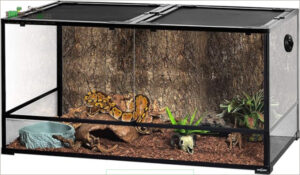
When choosing a home for your Blue-Eyed Leucistic Ball Python, the Reptizoo Large Reptile Terrarium is an excellent choice. Measuring 48" x 24" x 24" with a 120-gallon capacity, it provides ample space for your python’s needs.
The terrarium features a sliding front door for easy access, a removable screen top for ventilation, and a raised bottom plate for heating pads.
With its durable tempered glass and secure locking system, this enclosure guarantees your python’s safety and comfort, making it a reliable choice.
Best For: Bearded dragons, tortoises, pythons, hedgehogs, and other reptiles and amphibians.
- Ample space with 120-gallon capacity
- Durable tempered glass for safety and visibility
- Sliding front door, removable screen top, and raised bottom plate for easy access and ventilation
- No included heating or lighting equipment
- May be heavy and difficult to move
- May not be suitable for all species of reptiles or amphibians
2. Zoo Med Forest Floor Bedding
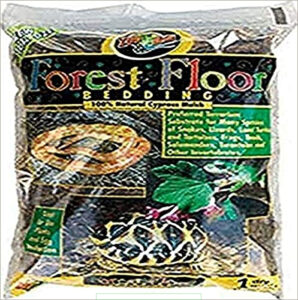
Zoo Med Forest Floor Bedding offers an excellent substrate choice for your Blue-Eyed Leucistic Ball Python. Made from cypress mulch, it mimics a natural forest floor, effectively retaining moisture necessary for maintaining appropriate humidity levels in the enclosure.
It’s well-suited for snakes, amphibians, and tortoises. The 24-quart bag size fits well into various terrarium setups, measuring 18 x 12 x 6 inches.
This bedding provides a secure and comfortable environment, essential for a healthy and stress-free snake life.
Best For: Snakes, amphibians, and tropical tortoises
- Natural "forest floor" look
- Retains moisture for humidity
- Provides a secure and comfortable environment
3. Vivosun Reptile Heating Pad Thermostat Combo
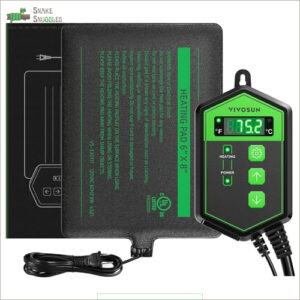
The Vivosun Reptile Heating Pad Thermostat Combo is ideal for maintaining proper temperatures in your Blue-Eyed Leucistic Ball Python’s enclosure. It offers precise temperature control between 40–108°F, guaranteeing a stable environment.
The thermostat displays temperature ranges from 32–210°F, providing a wide monitoring scope. Its compatibility with any heat mat and easy installation options—bottom or side mounting—make it versatile.
Safety is ensured with UL approval, making this heating pad a reliable choice for your pet’s comfort and health.
Best For: Reptile owners who need precise temperature control for their reptile enclosures.
- Precise temperature control between 40–108°F
- Wide monitoring scope with temperature ranges from 32–210°F
- Versatile compatibility with any heat mat and easy installation options
- May not be suitable for all reptile species
- Requires a separate heat mat
- Thermostat may not be waterproof
4. Galapagos Terrarium Sphagnum Moss
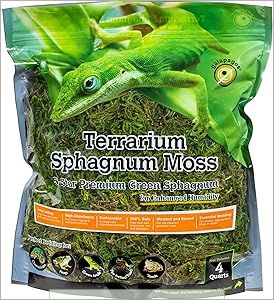
The Galapagos Terrarium Sphagnum Moss is perfect for maintaining the ideal humidity levels for your Blue-Eyed Leucistic Ball Python. This long-fibered, green moss is sustainably sourced and non-toxic, providing a natural and elegant look to your reptile’s habitat.
Its excellent moisture retention enhances humidity, essential for your python’s shedding and overall health. This moss is also versatile, suitable for home and garden décor, complementing the aesthetic while ensuring your python’s comfort and well-being.
Best For: Blue-Eyed Leucistic Ball Pythons and other tropical and temperate species.
- Excellent moisture retention for ideal humidity levels
- Provides a natural and elegant look
- Versatile, can be used for home and garden décor
- Not live sphagnum moss
- Some of the moss has been spray-painted green
- May need to be reset and reused multiple times
5. Zoo Med Digital Thermometer Humidity Gauge
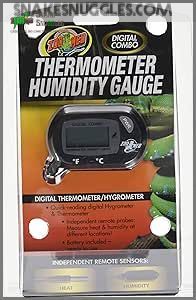
The Zoo Med Digital Thermometer Humidity Gauge guarantees precise environmental control for your Blue-Eyed Leucistic Ball Python. With its waterproof probe and digital readout, monitoring temperature and humidity becomes a breeze.
The device’s accuracy, down to the decimal, allows for optimal care conditions. Despite minor issues like long wiring and difficult display angles, the benefits outweigh these drawbacks. This gauge helps maintain the perfect habitat, ensuring your python’s comfort and health over their long lifespan.
Best For: Blue-Eyed Leucistic Ball Python owners seeking precise environmental control.
- Waterproof probe
- Digital readout for easy reading
- Accuracy down to the decimal
- Long wiring for probes
- Suction cups may not hold well
- Display may be difficult to read at an angle
6. Repti Zoo Reptile Mister Fogger
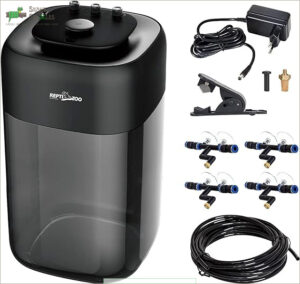
The Repti Zoo Reptile Mister Fogger is an exemplary choice for maintaining humidity levels in your Blue-Eyed Leucistic Ball Python’s enclosure. With a 2.6-gallon capacity, it ensures consistent moisture. Its super silent pump and 360-degree spray nozzle distribute water evenly, reducing stress for your snake.
The adjustable rainfall system mimics natural conditions, promoting well-being. Despite potential nozzle issues, the Mister Fogger’s reliable performance makes it indispensable for proper ball python care, providing a favorable environment for their health and comfort.
Best For: Blue-Eyed Leucistic Ball Pythons and other reptiles that require high humidity levels.
- Super silent pump
- 360-degree spray nozzle for even distribution
- Adjustable rainfall system mimics natural conditions
- Nozzles may have difficulty sticking to vivariums
- Some nozzles may spring a small leak and drip water
- Power supply contacts may get wet and risk electrical fire/sparking
Potential Health Issues in Blue-Eyed Leucistic Ball Pythons
Blue-eyed leucistic ball pythons are remarkably free from most genetic issues, but it’s still essential to schedule regular vet checkups to verify their overall well-being. Regular vet visits can detect any potential health problems early, such as respiratory infections or mites, which are often related to improper husbandry.
Rarely Suffer From Genetic Issues
Blue-eyed leucistic ball pythons are genetically unique, making them distinct and prized. They’re rarely afflicted by genetic issues and generally exhibit robust health due to their selective breeding. However, their scarcity greatly affects their availability.
- Genetic origin guarantees distinct appearance.
- Minimal health implications observed.
- Rare morphological differences.
- Breeding challenges uphold quality.
- Rarity enhances their allure.
Regular Vet Checkups Are Recommended
Regular vet checkups are critical for your blue-eyed leucistic ball python’s health, given their susceptibility to respiratory infections, mites, and scale rot. Veterinarian recommendations can pinpoint issues early, ensuring a long, healthy life. Regular visits promote disease prevention and monitor captive breeding health, addressing any genetic diversity concerns that may arise, thereby contributing to lifespan extension.
Behavior and Temperament of Blue-Eyed Leucistic Ball Pythons
Blue-Eyed Leucistic Ball Pythons are known for their docile nature and ease of handling, but they require careful support when being held to avoid stress. They tend to curl into a ball when uneasy and prefer quiet environments, being most active during dawn and dusk.
Docile and Easy to Handle
Blue-Eyed Leucistic Ball Pythons are known for their behavioral traits, being docile and easy to handle. Captive breeding has helped solidify their temperament differences. Proper handling techniques guarantee they’re undisturbed, as they’re shy and prefer quiet environments. Incorporating enrichment activities, like climbing structures, keeps them engaged and reduces stress, promoting a healthier temperament overall.
Should Be Handled With Care and Support
When handling your Blue-Eyed Leucistic Ball Python, use appropriate support techniques. Make certain you support its entire body to prevent stress and injury. Early socialization and handling frequency are essential in making your snake comfortable with human interaction. Always take safety precautions and be gentle, respecting its docility and natural behaviors.
May Curl Up Into a Ball When Stressed
When stressed, the Blue-Eyed Leucistic Ball Python often curls into a ball shape, a classic defensive posture. This stress response is a natural instinct to protect their head. When handling them, always support their entire body and make sure the enclosure size is appropriate, as inadequate space can increase stress levels.
Are Shy and Prefer Quiet Environments
Blue-eyed leucistic ball pythons are shy creatures that prefer quiet environments. To facilitate their well-being:
- Enclosure size: Provide a spacious, secure habitat.
- Handling frequency: Handle gently and infrequently to reduce stress.
- Feeding habits: Maintain consistent feeding schedules.
- Socialization: Minimize disruptions to their tranquil space.
These practices support their calm demeanor and longevity.
Most Active During Dawn and Dusk
They tend to be most active during dawn and dusk, exhibiting nocturnal behavior. During this time, their eye color and potential tan stripe may be visible. Hatchlings are more energetic and smaller in size compared to adults. This period of activity provides an excellent time for observation.
| Time of Day | Activity Level | Visibility | Size Difference |
|---|---|---|---|
| Dawn | High | High | Hatchlings small |
| Morning | Low | Low | Adults larger |
| Dusk | High | High | Visible features |
| Night | Moderate | Moderate | Energetic |
Lifespan and Long-Term Commitment
Blue-Eyed Leucistic Ball Pythons live an average of 20-30 years, with the record for the oldest captive ball python being 47 years. When you decide to get one, be prepared for a long-term commitment to guarantee its lifelong care and well-being.
Live 20-30 Years on Average
Blue-Eyed Leucistic Ball Pythons live 20-30 years on average, requiring significant commitment. To guarantee their longevity:
- Provide a proper enclosure: At least 40-gallons for adults.
- Maintain appropriate environmental conditions: Temperature gradient and humidity range.
- Regular vet checkups: Monitor for potential health issues.
This guarantees a healthy, long-lived snake.
Record for Oldest Captive Ball Python is 47 Years
With proper care and attention, ball pythons can live remarkably long lives. The record for the oldest captive ball python is 47 years, emphasizing their impressive longevity. Maintaining their health and meeting their needs consistently is imperative. Your commitment to their captive care directly influences their lifespan, ensuring these reptiles thrive under your watch.
Require Long-term Commitment
Given their remarkable longevity, sometimes reaching up to 30 years or more, owning a Blue-Eyed Leucistic Ball Python is a long-term commitment. Proper care, including specific needs for morphs and ensuring captive breeding from reputable sources, is essential. Planning for their future is imperative, as their extended lifespan requires dedication and consistent, specific care.
Frequently Asked Questions (FAQs)
Are blue-eyed leucistic ball pythons rare?
Yes, blue-eyed leucistic ball pythons are rare. They’re highly sought after and uncommon in the pet trade due to specific breeding requirements involving Mojaves, Lessers, Butters, Phantoms, and Het Russos.
Are blue-eyed leucistic ball pythons poisonous?
Blue-eyed leucistic ball pythons aren’t poisonous. Like all ball pythons, they’re non-venomous and rely on constriction to subdue prey. Handling them safely and correctly will help you avoid getting bitten due to stress or mishandling.
How to get a blue eyed lucy ball python?
To get a blue-eyed leucistic ball python, purchase from reputable breeders specializing in Mojaves, Lessers, Butters, Phantoms, and Het Russos. Confirm they’re captive-bred for health benefits. Proper care and secure enclosures are essential for their wellbeing.
What is the personality of a leucistic ball python?
You’ll find leucistic ball pythons to be docile and easy-going. They’re typically shy, preferring quiet environments. These snakes are most active at dawn and dusk. With proper handling, they’ll become comfortable and relaxed in your presence.
How often should ball pythons be fed?
Picture a coiled serpent, patiently waiting for its next meal. You’ll feed your ball python every 7-14 days, depending on age and size. Young snakes eat weekly, while adults can go up to two weeks between meals.
What is the average hatching size?
You’ll find that newly hatched ball pythons typically measure between 10 and 17 inches in length. They’re tiny bundles of scales, weighing just 50-80 grams. It’s fascinating how these little noodles grow into impressive adults!
Are blue-eyed leucistic ball pythons good with children?
You’d be amazed! These snakes are incredibly gentle giants. They’re docile and easy to handle, making them excellent companions for children. However, always supervise interactions and teach proper handling techniques to guarantee everyone’s safety and comfort.
How do I maintain humidity levels?
To maintain proper humidity, mist the enclosure daily and provide a large water dish. Use a hygrometer to monitor levels, aiming for 50-60%. Add moss or damp substrate in a hide box for additional moisture when needed.
Can they cohabitate with other reptiles?
You shouldn’t cohabitate reptiles of different species. Each has unique needs and behaviors that can conflict. Mixing species risks stress, aggression, and disease transmission. It’s best to house your ball python separately for its health and safety.
Conclusion
Did you know that the oldest recorded captive ball python lived to be 47 years old? As you contemplate bringing a blue-eyed leucistic ball python into your home, keep in mind that you’re committing to a long-term companion.
These stunning snakes require specific care, including a proper enclosure, temperature control, and regular handling. While they’re rare and sought-after, make sure you’re prepared for their unique needs.
With the right care, your blue-eyed leucistic ball python can thrive for decades, offering you a beautiful and fascinating pet.

